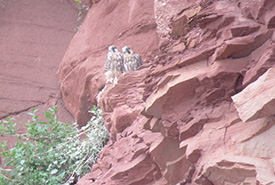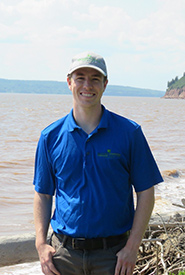Close encounters with a peregrine falcon

Peregrine falcons (Photo by Evan Young/NCC)
NCC’s Johnson’s Mills Shorebird Reserve and Interpretive Centre in New Brunswick, on the Bay of Fundy, is located on the route of one of the world’s most spectacular bird migrations. The Bay of Fundy is a stopover site for hundreds of thousands of semipalmated sandpipers, who rest and feed here each summer as they make their way to South America. While these shorebirds are considered the stars of the show, another feathered friend also lives here.
Peregrine falcons — a species that has recovered from near extinction — nest at Johnson’s Mills, high in the cliffs of nearby Dorchester Cape. They use the nearby fields and surrounding shores as hunting grounds. The bevy of wildlife that inhabit the area both seasonally and year-round ensures that these predators have enough food for themselves and any offspring they may have.
At the beginning of each summer season, NCC’s shorebird interpreters at the centre are tasked with searching for a peregrine falcon nest, which has been found around Dorchester Cape for the last few years.
Two groups of interns went in search of the nest. The first group had heard the peregrine's calls but never saw the birds. The second group was comprised of myself and Kaylie. We were walking down the beach, looking along the cliffs for the falcon’s white-coloured scat. Twenty minutes had gone by, with no signs of the bird.

Peregrine falcons (Photo by NCC)
We were a good 500 metres past where our co-workers had first heard the falcon. Ready to give up and turn back, we heard a distinct and angry cry coming from the top of the cape. We looked up and saw the silhouette of a peregrine falcon. For some of us, this was the first peregrine falcon we had ever seen in the wild. It was clear this falcon was unhappy with us being there, but we were happy to return to the interpretive centre with our news.
We returned to the location where we had sighted the peregrine falcon several times. Each time we were met with screeching and had to turn back. On our fourth attempt we were able to get closer to our goal. We rounded the bend that the falcon had so ferociously guarded. It was new territory for us. We scanned the cliffs of Dorchester Cape looking for any indication of a nest. After a minute or two of scouring the cliffs, we were prepared to move on. Then, right before we were about to move on, we heard its now familiar screech.
Automatically, we began to step back. We were expecting a peregrine falcon to circle over our heads until we left the area. As it turned out, the falcon’s screech wasn’t coming from above, but instead from the cliffs. Sure enough, there they were: two parents guarding their nest. This time, we paused to watch and enjoy them, the first time they let us stay for longer than a minute. We took the co-ordinates of the nest location and headed back to the centre once again to share our discovery.
The presence of a nesting pair of peregrine falcons at NCC’s Johnson’s Mills nature reserve is especially astounding considering the threats they have faced in previous decades. The introduction of DDT in the 1960s caused the shells of peregrine eggs to thin. The thin shells disrupted the development of the embryos and led to a massive decline in peregrine falcon populations. In addition, the birds ingested the chemical when they fed on insects and animals exposed to DDT. Before long, the peregrine falcon was facing extinction. Fortunately, thanks to conservation measures such as a ban on DDT, the peregrine falcon is making a comeback.
Now the peregrine falcon is returning to many parts of Canada, although it is still listed as special concern under Canada’s Species at Risk Act. What we can do is ensure that we disturb the birds as little as possible. We can change our behaviours and habits to best conserve and protect all species, and establish nature reserves like the one at Johnson’s Mills. We owe it to the sandpipers, and the peregrine falcons, that we let them live and hunt and screech as loud as they want.
The Conservation Internship Program is funded in part by the Government of Canada’s Summer Work Experience program.


